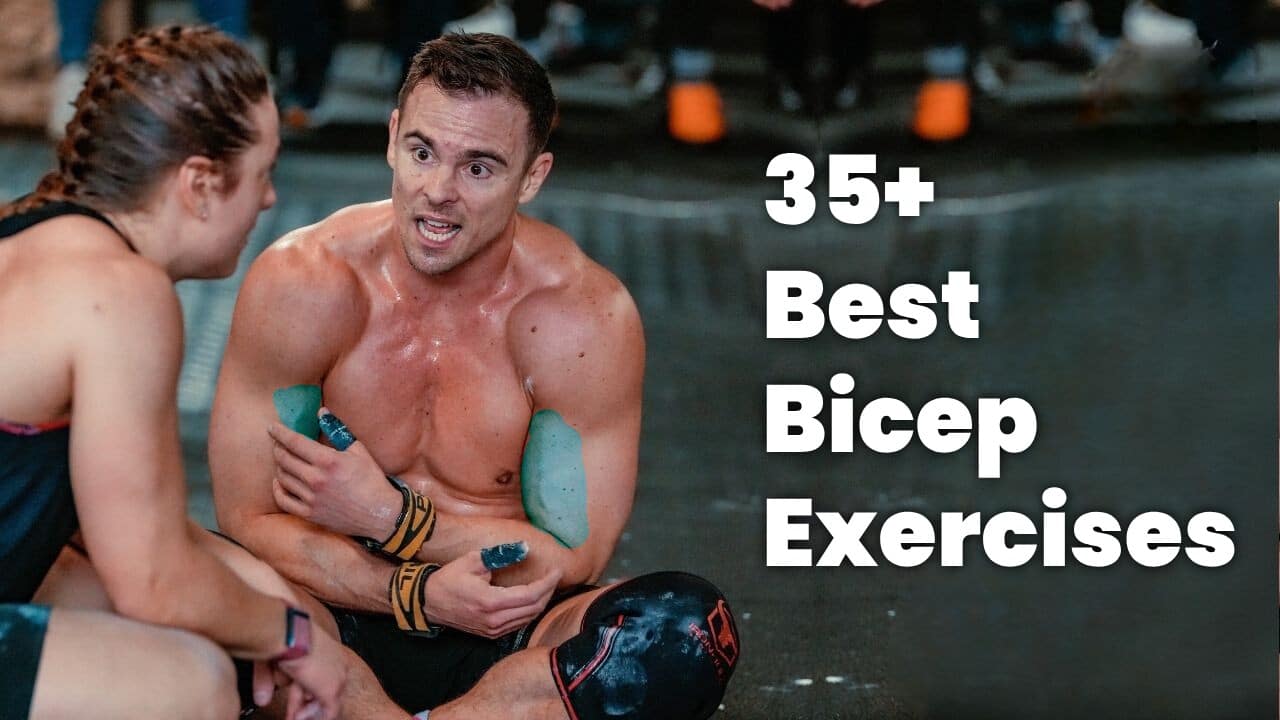Dive into the world of bicep training with our comprehensive guide on the best bicep exercises and workouts, designed to sculpt powerful, well-defined arms.
From the intricacies of bicep anatomy to a curated selection of exercises that target every inch of your muscles, this article is your roadmap to achieving the arm strength and aesthetics you’ve always desired.
Learn how to avoid common workout pitfalls and discover the optimal rep ranges for growth, whether slow curls really make a difference, etc.
With routines ranging from beginner to advanced, including equipment-free options, we’ve got every base covered.
Jump to:
- Comprehensive List of Bicep Exercises
- Standing Barbell Curl
- Incline Dumbbell Curl
- Dumbbell Biceps Curl
- Dumbbell Hammer Preacher Curl
- EZ-Bar Curl
- Zottman Curl
- Overhead Cable Curl
- Incline Inner-Biceps Curl
- Standing Concentration Dumbbell Curl
- Reverse Curl Straight Bar
- Concentration Curl
- Twisting Dumbbell Curl
- Prone Dumbbell Spider Curl
- Leant-Forward EZ Bar Curl
- Banded Bicep Curl
- Fat-Grip Hammer Curl
- Behind-the-Back Cable Curl
- Reverse Curl
- Drag Curl
- Cheat Curl
- Band Curl
- Side Curl
- Spider Curl
- Meadows Row
- Decline Dumbbell Curl
- Cable Rope Hammer Curl
- Barbell Bent-Over Row
- Chin-up
- Pull-Ups
- Towel Grip Pull-up
- Inverted Row
- Underhand Seated Row
- Seated Cable Row
- Suspension Trainer Biceps Curl
- TRX Suspension Curl
- Bicep Workouts and Programs
- Best Biceps-Building Programs
- Common Mistakes and Tips
- Understanding Your Biceps
- What Are Your Biceps?
- References
Comprehensive List of Bicep Exercises
Ok, so what are the best bicep exercises? Here’s what the science says:
- Bicep Curl Variants and Arm Exercises: Incorporating exercises like bicep curls, active pronator and supinator exercises, and isometric biceps exercises can effectively recognize and enhance arm and elbow strength, especially when monitored through innovative means such as smartphones’ accelerometers (Javed, Awan, & Hussain, 2017).
- Muscle Fiber Hypertrophy with Resistance Training: Resistance training, particularly exercises that focus on the forearm flexors, can lead to significant increases in muscle cross-sectional area, fiber areas, and capillary density, contributing to bicep strength and hypertrophy (McCall et al., 1996).
- Self-Resistance and Isometric Exercises: Self-resistance exercises, including bilateral and unilateral isometric contractions, can effectively engage the bicep muscles, providing a practical approach to strength development without the need for equipment (Serrau et al., 2012).
- Learning and Motor Program Adaptations: Training that involves complex arm movements, such as those engaging the bicep muscles, can lead to improvements in speed and coordination, attributed to modifications in motor programs and learning, emphasizing the role of practice and repetition in strength training (Normand et al., 1982).
Standing Barbell Curl
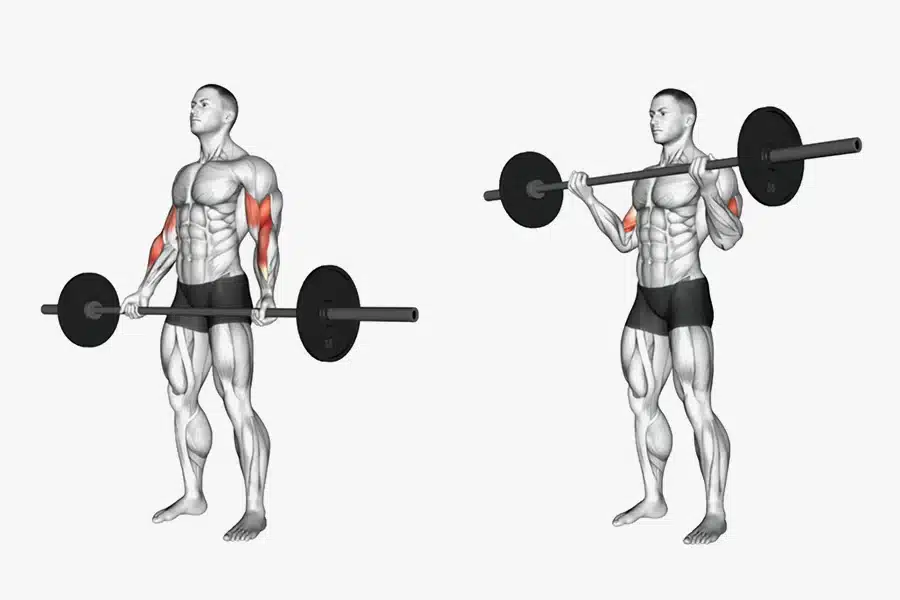
Stand upright holding a barbell with an underhand grip, hands shoulder-width apart. Curl the bar towards your chest, then lower back down with control. The whole biceps brachii muscle is engaged, offering a comprehensive growth stimulus.
Incline Dumbbell Curl
Position yourself on an incline bench set at a 45-degree angle. With a dumbbell in each hand, palms facing forward, curl the weights while keeping your elbows and back stationary. This exercise primarily targets the long head of the biceps, emphasizing the peak.
Dumbbell Biceps Curl

Stand or sit with a dumbbell in each hand, palms facing forward. Curl the weights while keeping your upper arms stationary. This classic exercise focuses on the biceps brachii with an emphasis on the peak when performed with proper form.
Dumbbell Hammer Preacher Curl
Sit at a preacher bench, holding a dumbbell in each hand with a neutral grip. Curl the weights towards your shoulders, ensuring your upper arms remain stationary. This variant effectively works the brachialis muscle, which lies beneath the biceps brachii.
EZ-Bar Curl

Using an EZ-bar allows for a semi-supinated grip, which can reduce wrist strain. Curl the bar towards your chest, then lower it slowly. This exercise targets both the biceps brachii and the brachialis, providing a balanced arm workout.
Zottman Curl
Perform a traditional dumbbell curl but rotate your wrists at the top of the movement so your palms face down, then lower the weights. Rotate back to start position and repeat. The Zottman curl targets the biceps brachii, brachialis, and brachioradialis, offering a comprehensive forearm and bicep workout.
Overhead Cable Curl
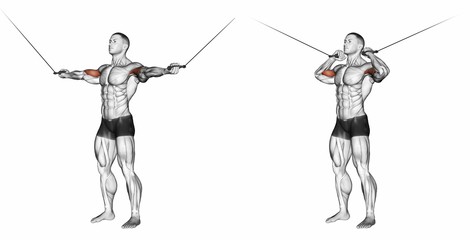
Stand between two cable machines, grasping each cable with an underhand grip. Curl your hands towards your ears in a wide arc. This innovative exercise targets the short head of the biceps, enhancing the bicep peak with a unique tension angle.
Incline Inner-Biceps Curl
Sit on an incline bench with dumbbells in each hand, palms facing forward. Curl the weights while keeping your elbows back, focusing on squeezing at the top. This move specifically targets the inner portion of the biceps brachii, aiding in the development of arm thickness.
Standing Concentration Dumbbell Curl
Stand with feet shoulder-width apart, leaning slightly forward with a dumbbell in one hand. Curl the weight towards your shoulder, isolating the biceps. This exercise intensely targets the biceps brachii, particularly the peak, by preventing other muscles from assisting.
Reverse Curl Straight Bar

Hold a barbell with an overhand grip, hands shoulder-width apart. Curl the bar towards your shoulders, keeping your elbows close to your body. The brachioradialis and brachialis are the primary muscles engaged, along with the biceps brachii.
Concentration Curl
Sit on a bench and lean forward slightly, holding a dumbbell in one hand. Curl the dumbbell towards your shoulder, isolating the bicep. This exercise targets the biceps brachii, particularly the peak, for focused muscle growth.
Twisting Dumbbell Curl
Start with dumbbells at your sides, palms facing your body. As you curl the weights, rotate your wrists so your palms face your shoulders at the top. This movement engages the biceps brachii throughout its full range of motion, emphasizing both heads of the muscle.
Prone Dumbbell Spider Curl

Lie face down on an incline bench, arms hanging straight down with a dumbbell in each hand. Curl the weights towards your shoulders, keeping your elbows stationary. The biceps brachii is the primary muscle worked, with this angle placing intense focus on the contraction.
Leant-Forward EZ Bar Curl
Lean slightly forward while standing and curl an EZ bar towards your chest. This angle targets the biceps brachii, especially the long head, by altering the tension throughout the curl.
Banded Bicep Curl
Attach a resistance band to a low anchor point or stand on it, holding the other end with both hands. Curl your hands towards your shoulders. Resistance bands offer a unique tension curve, emphasizing the biceps brachii throughout the movement.
Fat-Grip Hammer Curl
Hold dumbbells with a wider grip, either using fat grips or a thicker handle. Perform hammer curls with palms facing each other. This exercise targets the brachialis and brachioradialis, improving arm thickness and grip strength.
Behind-the-Back Cable Curl

Stand facing away from a low cable pulley with a handle attached. Reach behind and curl the handle towards your glutes, keeping your palm facing up. This exercise isolates the biceps brachii, particularly emphasizing its short head.
Reverse Curl
Hold a barbell or dumbbells with an overhand grip, hands shoulder-width apart. Curl the weights towards your shoulders, keeping your elbows close to your torso. The brachioradialis and brachialis are the primary muscles worked, along with the biceps brachii.
Drag Curl
Stand with a barbell, palms facing forward. Instead of curling the bar directly up, drag it along your body as you bend your elbows and lift the bar. This exercise maximally engages the biceps brachii, especially the long head, by keeping the tension focused through a unique range of motion.
Cheat Curl
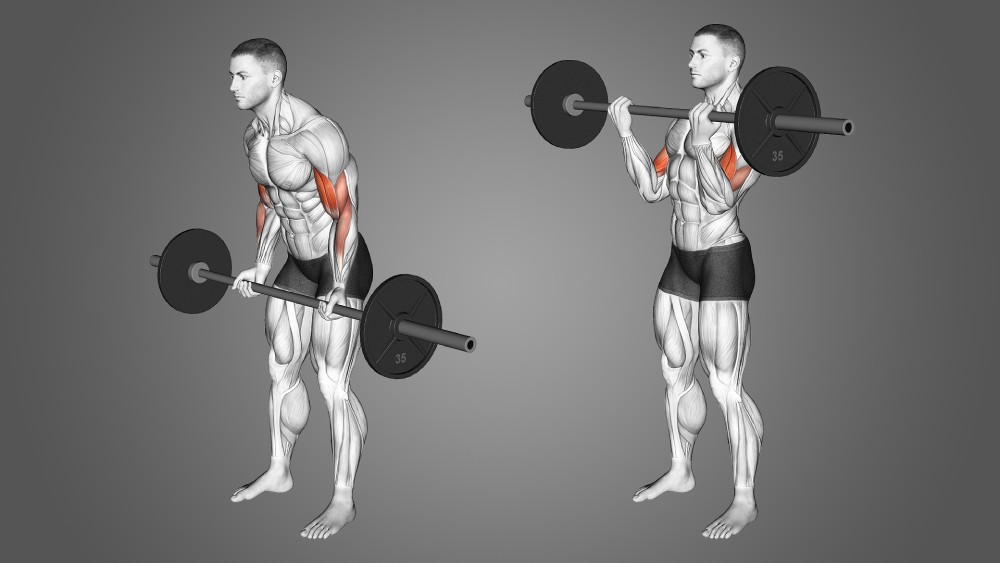
Stand with feet shoulder-width apart, holding a barbell with an underhand grip. Perform a traditional curl, but allow a slight momentum from your hips at the beginning to lift heavier weights. This technique targets the biceps brachii while allowing you to overload the muscle, stimulating growth.
Band Curl
Secure a resistance band under your feet, holding the other end with both hands. Curl your hands towards your shoulders, keeping elbows fixed. Resistance bands provide constant tension throughout the movement, emphasizing the biceps brachii for strength and endurance.
Side Curl
Stand holding dumbbells at your sides, palms facing your body. Without moving your upper arms, curl one weight towards the same-side shoulder, twisting your wrist so your palm faces up at the top. This isolates the biceps brachii, particularly focusing on unilateral strength and muscle balance.
Spider Curl
Lie face down on an incline bench with dumbbells or a barbell. Curl the weights towards your shoulders, keeping elbows stationary. This position isolates the biceps brachii, minimizing momentum and maximizing muscle contraction at the top of the movement.
Meadows Row

Position yourself beside a landmine unit or a barbell secured in a corner. Bend over and grasp the bar with one hand, performing a row. This unique angle intensively works the biceps brachii and the back, named after the legendary bodybuilder who popularized it.
Decline Dumbbell Curl
Lay face-up on a decline bench, holding dumbbells with palms facing forward. Without moving your upper arms, curl the weights towards your shoulders. This position intensifies the focus on the biceps brachii, particularly its long head, by altering the gravity angle.
Cable Rope Hammer Curl
Stand in front of a cable machine, attaching a rope to the low pulley. Grip the rope with hands parallel and elbows fixed by your sides. Curl the hands towards your shoulders, targeting the brachialis and biceps brachii for well-rounded arm development.
Barbell Bent-Over Row
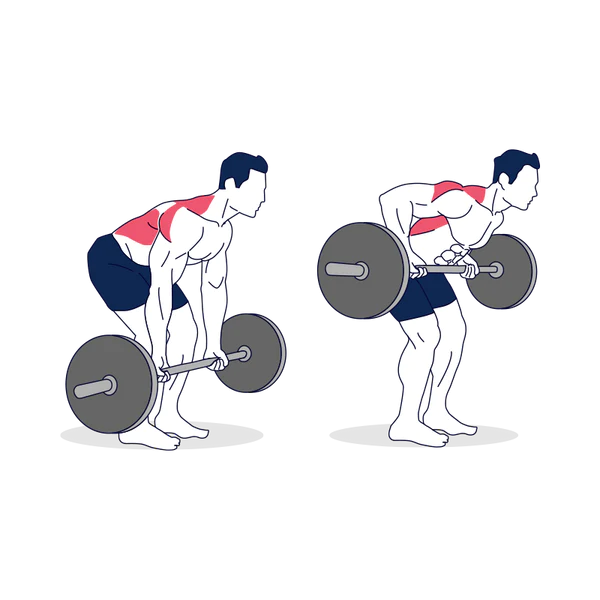
Lean forward, maintaining a straight back, and grasp a barbell with an underhand grip. Pull the bar towards your lower chest, engaging your biceps and lats. Primarily, this exercise targets the biceps brachii, along with significant back muscle engagement.
Chin-up
Grasp a pull-up bar with a shoulder-width underhand grip. Pull your body up until your chin is over the bar, focusing on squeezing your biceps at the top. The biceps brachii and brachialis are intensely worked, making chin-ups a powerful compound exercise for bicep growth.
Pull-Ups

Start with an overhand grip on the pull-up bar, hands wider than shoulder-width apart. From a hanging position with your arms fully extended, pull yourself up until your chin is over the bar. This movement engages the lats and biceps brachii throughout its full range of motion, emphasizing both muscle groups.
Towel Grip Pull-up
Loop towels over a pull-up bar and grasp each end for your grip. Perform pull-ups as usual. This variation not only targets the biceps brachii but also significantly increases grip strength due to the towel’s thickness.
Inverted Row
Set up a bar in a rack at waist height. Lie underneath it, grabbing the bar with an underhand grip. Pull your chest towards the bar, squeezing your biceps and back. This exercise works the biceps brachii and back muscles, offering a functional strength challenge.
Underhand Seated Row
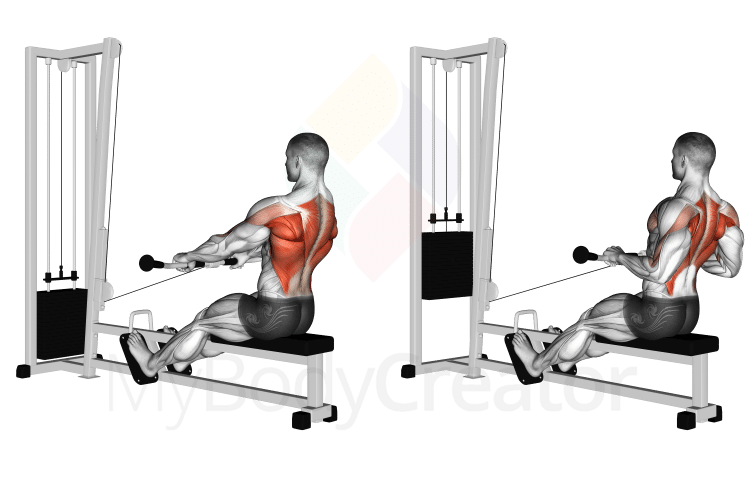
Sit at a cable row machine with an underhand grip on the handle. Pull the handle towards your waist, keeping your back straight. This exercise targets the biceps brachii and brachialis, in addition to the back muscles, for a comprehensive upper body workout.
Seated Cable Row
Sit at a cable row station with a straight bar or V-handle attachment. Pull the handle towards your lower abdomen, keeping your back straight. This exercise engages the biceps brachii alongside the back muscles, enhancing pulling strength.
Suspension Trainer Biceps Curl
Grip the handles of a suspension trainer and lean back with your body straight and heels planted. Curl your body up by bending your elbows, keeping your body rigid. This exercise intensely targets the biceps brachii with bodyweight resistance, enhancing core engagement and stability.
TRX Suspension Curl

Face towards the anchor point of a TRX suspension trainer, gripping the handles with palms facing up. Lean back, extending your arms, then curl your body towards your hands, bending at the elbows. This bodyweight exercise targets the biceps brachii and incorporates significant core engagement.
Bicep Workouts and Programs
Diving into the world of bicep training unveils a myriad of methods to sculpt powerful, well-defined arms. Below is an ultimate guide designed to push your biceps to their full potential, incorporating a blend of traditional lifts, innovative techniques, and targeted routines.
The Ultimate Bicep Workout Guide
Big Exercises: Kickstart your journey with foundational movements known for their effectiveness in building mass and strength. The Barbell Cheat Curl allows for heavy lifting with a controlled momentum, aggressively targeting the biceps brachii. Weighted Chin Ups challenge your biceps and back, utilizing bodyweight and additional resistance for comprehensive upper body development. Incorporate Banded Dumbbell Curls to exploit the resistance band’s unique tension, enhancing muscle activation throughout the curl.
Biceps Curl Trifecta for Intensity and Shoulder Rotation: This trifecta combines different curl variations to maximize bicep growth and improve shoulder rotation. Start with Standing Barbell Curls for bulk, transition to Hammer Curls to hit the brachialis, and finish with Concentration Curls for peak isolation.
Recommended Routines
Biceps Workout 1:
- Barbell Cheat Curl – 4 sets of 8 reps
- Weighted Chin Up – 3 sets of 6 reps
- Banded Dumbbell Curl – 3 sets of 10 reps
- Hammer Curl – 3 sets of 12 reps
Biceps Workout 2:
- EZ-Bar Curl – 4 sets of 10 reps
- Incline Dumbbell Curl – 3 sets of 10 reps
- Preacher Curl – 3 sets of 12 reps
- Reverse Curl – 3 sets of 15 reps for forearm engagement
Best Biceps-Building Programs
Maximize your bicep growth with these meticulously crafted workout programs. From heavy lifting to no-equipment routines, each is designed to cater to different training levels and preferences.
Hard and Heavy Biceps Workout
Target: Advanced lifters seeking mass and strength gains.
- Barbell Cheat Curl: 4 sets of 6-8 reps
- Weighted Chin-ups: 4 sets of 5-7 reps
- Dumbbell Hammer Curl: 3 sets of 8 reps
- EZ-Bar Preacher Curl: 3 sets of 6-8 reps
- Overhand Grip Barbell Curl (Reverse Curl): 3 sets of 8-10 reps
Focus on lifting heavy with proper form, allowing slight momentum on cheat curls to overload the biceps.
Biceps Workout for Beginners
Target: Newcomers aiming to build a solid bicep foundation.
- Dumbbell Biceps Curl: 3 sets of 10-12 reps
- Hammer Curl: 3 sets of 10-12 reps
- Standing Barbell Curl: 3 sets of 10-12 reps
- Concentration Curl: 2 sets of 12-15 reps per arm
- Cable Bicep Curl: 3 sets of 12-15 reps
This routine introduces fundamental movements, focusing on technique and muscle activation.
Machine Pump Biceps Workout
Target: Individuals preferring machines for a focused pump.
- Cable Curl with Straight Bar Attachment: 4 sets of 12-15 reps
- Machine Preacher Curl: 3 sets of 10-12 reps
- Standing Cable Hammer Curl with Rope Attachment: 3 sets of 12-15 reps
- Dual Cable Curl: 3 sets of 12-15 reps
- Machine Bicep Curl: 4 sets of 10-12 reps
Leverage machine stability for continuous tension and an intense bicep pump.
The 12 Week Plan to Badass Arms
Target: Those dedicated to transforming their arms over 3 months.
- Weeks 1-4: Foundation Building
- Barbell Curl: 3 sets of 12 reps
- Hammer Curl: 3 sets of 12 reps
- Concentration Curl: 3 sets of 15 reps per arm
- Weeks 5-8: Intensity Increase
- EZ-Bar Preacher Curl: 4 sets of 10 reps
- Incline Dumbbell Curl: 4 sets of 10 reps
- Reverse Curl: 3 sets of 12 reps
- Weeks 9-12: Volume and Intensity
- Cheat Curl: 4 sets of 6 reps
- Weighted Chin-ups: 4 sets of 8 reps
- 21s (7 low, 7 high, 7 full range): 3 sets
Progress by increasing weights and incorporating advanced techniques.
No Weight Bicep Workout
Target: Those without access to gym equipment.
- Chin-ups: 4 sets of 8-12 reps
- Diamond Push-ups: 3 sets of 12-15 reps
- Towel Curl (using a sturdy towel under a door or with a partner): 3 sets of 10-15 reps
- Plank to Push-up Position: 3 sets of 8-10 reps per arm
- Static Hold Chin-up: 2 sets of max time
This program utilizes bodyweight exercises and household items to challenge the biceps, proving that effective workouts can happen anywhere.
Common Mistakes and Tips
Embarking on a journey to enhance your biceps requires not just hard work but also smart strategies and the wisdom to sidestep common pitfalls. Let’s delve into some prevalent mistakes and share essential tips to elevate your bicep workouts.
Bicep Exercise Mistakes to Avoid
Lifting Too Heavy, Too Soon: Eager to see results, many rush into lifting heavier weights than they can manage with proper form. This not only hampers muscle growth but also increases injury risk. Focus on mastering form with manageable weights before gradually increasing the load.
Neglecting Full Range of Motion: Skimping on extending and curling through the full range limits muscle engagement and growth. Ensure each rep moves through the entire range to fully stimulate the biceps.
Overtraining: Biceps are a small muscle group that recovers quickly, yet they need rest. Bombarding them with daily heavy workouts can lead to overtraining and stall progress. Incorporate rest days to allow for muscle repair and growth.
How Many Reps to Grow Biceps?
Optimal rep ranges for bicep growth generally fall between 8-12 reps. This range strikes a balance between intensity and volume, promoting both strength and hypertrophy. Adjust the weight to challenge yourself in this rep range, ensuring the last few reps feel demanding yet achievable.
Should Bicep Curls Be Done Slow?
Yes, incorporating slow, controlled movements, especially during the eccentric (lowering) phase of bicep curls, can significantly enhance muscle growth. This technique increases time under tension, a crucial factor for hypertrophy. Aim for a 2-3 second lowering phase to maximize effectiveness.
Do Pushups Work Out Biceps?
While pushups primarily target the chest, shoulders, and triceps, they do engage the biceps to a lesser extent as stabilizing muscles. For targeted bicep growth, however, rely on pull-oriented exercises like curls and chin-ups that directly work the biceps.
Tips for Maximizing Bicep Development
- Vary Your Grip and Width: Altering your grip and the width of your hands during exercises like curls can target different parts of the biceps for balanced growth.
- Incorporate Isolation and Compound Movements: While curls isolate the biceps, compound movements like chin-ups and rows engage them alongside other muscle groups for overall upper body strength.
- Focus on Nutrition and Recovery: Adequate protein intake and sufficient rest are as crucial as your workout regimen for muscle growth and recovery.
- Consistency Over Intensity: Gradual, consistent progress in your workouts will yield better results than sporadic, intense sessions.
By avoiding common mistakes and applying these strategic tips, you can effectively enhance your bicep strength and aesthetics, achieving well-rounded and powerful arms.
Understanding Your Biceps
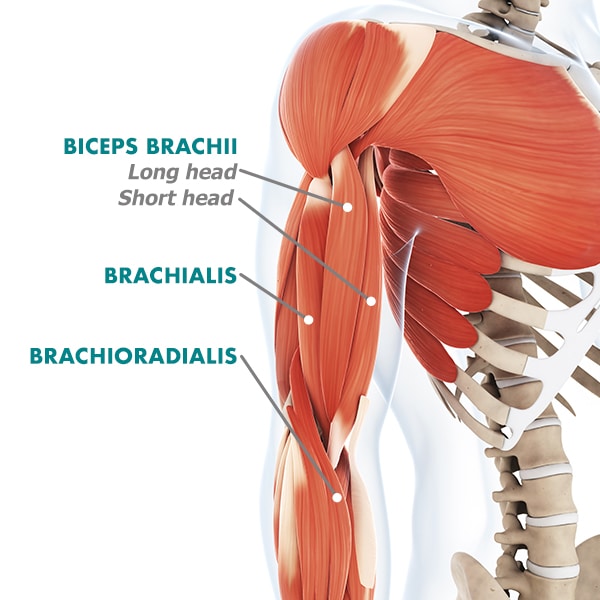
Overview of Bicep Anatomy and Importance of Bicep Training
At the heart of upper body strength and aesthetics, biceps brachii muscle, commonly known as biceps, plays a pivotal role. This muscle group, nestled between the shoulder and elbow, comprises two primary heads: the short head and the long head. Each contributes uniquely to the arm’s shape and function. Beneath these lies the brachialis, an often-overlooked muscle that significantly enhances the overall bicep mass and elbow flexion strength.
Benefits of Training Your Biceps
Support for Compound Lifts: Robust biceps are not just about looking good. They are crucial in stabilizing the arm during heavy compound lifts, such as rows and pull-ups, thereby contributing to a stronger, more balanced lifting profile.
Functional Fitness: Daily tasks, from lifting groceries to opening doors, engage your biceps. Strengthening this muscle group enhances your ability to perform these activities with ease, reducing the risk of injury.
Enhanced Physique: Well-developed biceps shape the upper arm, contributing to a more proportioned and aesthetically pleasing physique. They symbolize strength and are often a visible marker of fitness dedication.
What Are Your Biceps?
Your biceps are not just for show; they’re a functional duo tasked with three main actions: elbow supination, elbow flexion, and shoulder flexion. Elbow supination involves rotating the forearm to turn the palm up, while elbow flexion is the action of bending the arm at the elbow. Shoulder flexion moves the arm forward and up. Together, these movements facilitate numerous daily activities and athletic movements.
The Functions of the Biceps
The biceps’ functionality extends beyond simple flexion and rotation. They play a critical role in the dynamic stability of the elbow and shoulder joints. By understanding the biceps’ multifaceted role, individuals can target these muscles more effectively in their training regimen, ensuring both strength and functional mobility are developed harmoniously.
The Strength Curve of the Biceps
Exploring the strength curve of the biceps reveals insights into their performance across different ranges of motion. This curve indicates that biceps are most efficient in the mid-range of elbow flexion. Knowledge of this curve is pivotal in selecting exercises that maximize bicep growth and strength by challenging the muscle throughout its entire range of motion. Tailoring workouts to include a variety of movements ensures comprehensive development, avoiding imbalances and promoting optimal upper body function.
References
- TAHIR HUSSAIN, Tahir Javed, Muhammad Arshad Awan,. Recognition of Arm & Elbow Exercises using Smartphone’s Accelerometer. NFC IEFR Journal of Engineering and Scientific Research, [S.l.], v. 5, july 2017. ISSN 2521-0114
- Serrau, Virgile1; Driss, Tarak1; Vandewalle, Henry2; Behm, David G.3; Lesne-Chabran, Ethelle1; Le Pellec-Muller, Armande1. Muscle Activation of the Elbow Flexor and Extensor Muscles During Self-Resistance Exercises: Comparison of Unilateral Maximal Cocontraction and Bilateral Self-Resistance. Journal of Strength and Conditioning Research 26(9):p 2468-2477, September 2012. | DOI: 10.1519/JSC.0b013e31823bc0a2



